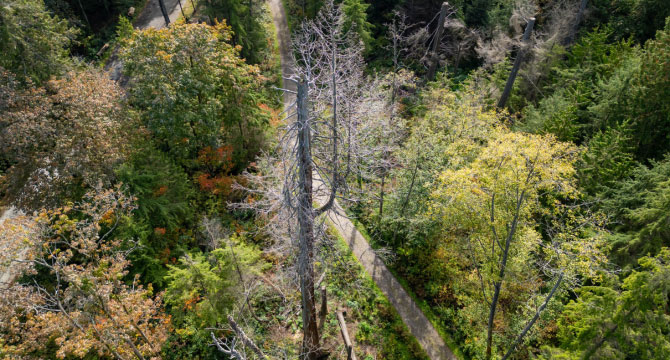
 Park Board approves final phase of work to address public safety risks caused by hemlock looper in Stanley Park
Park Board approves final phase of work to address public safety risks caused by hemlock looper in Stanley Park
Last night, Park Board Commissioners directed staff to proceed with the third and final phase of Hemlock Looper mitigation and restoration work in Stanley Park. The work is set to start in fall 2025 and wrap up in early 2027 – work will take place outside of the bird nesting season from October – April.
Earlier phases of work prioritized forest areas with greater exposure to public activity, critical infrastructure, and vehicle access, such as the seawall, Stanley Park Drive, and North Lagoon Drive.
Work in this last phase will focus on mitigating risk to the public from hemlock looper-affected trees adjacent to trails in the interior of the park, including Lovers Walk, Tatlow Walk and the paths around Beaver Lake.
“Our response efforts in Stanley Park have been vital to ensuring the continuing safety and well-being of park users, park infrastructure and wildlife species in the park,” said Park Board Chair Laura Christensen. “Further, it’s an opportunity to build a stronger Stanley Park that can better withstand future insect outbreaks and climate change impacts.”
Work to date
The Stanley Park Hemlock Looper Impact and Wildfire Risk Assessment PDF file (4.2 MB) details the extent of the damage in which 160,000 of the approximately 600,000 trees in Stanley Park are dead or dying. Across all phases of the work-to-date only a fraction of the impacted needed to be removed due to their risks to public safety.
The hemlock looper insect experiences population outbreaks roughly every 15 years, however the most recent outbreak resulted in significant tree mortality in the park causing an elevated risk to public safety.
During previous phases of this project, approximately 11,000 trees have been removed. The majority of trees removed thus far were western hemlock and 10 per cent were Douglas fir. No old growth trees were removed and all Douglas fir and western red cedar was shared with the Host Nations for ceremonial use.
In addition, over 50,000 new seedlings of diverse species have been planted – this has been supported through a 3-year donation from Western Forest Products. A total of 58% of Stanley Park’s forested areas have now been treated.